(with Brian Dixon)
 The JVC HA-NC250 Noise Canceling Headphones are JVC's new top-of-the-line model ($199 list, $139 street price) -- both with better performance and better comfort than the earlier HA-NC80 model.
The JVC HA-NC250 Noise Canceling Headphones are JVC's new top-of-the-line model ($199 list, $139 street price) -- both with better performance and better comfort than the earlier HA-NC80 model.
The soft earpieces provide good sound isolation, the new feedback technology adds noise reduction, and they are light weight and fold flat for travel
The headphones wear comfortably for long periods with the soft "memory foam" ear pads. The oval earpieces have a double housing structure with extra sound insulation layer, so they do a better job of sound isolation to begin with, blocking outside sounds.
You can use the headphones stand-alone (with no audio playing) to quiet your environment -- the 4 foot cord uses a standard audio jack and detaches from the headphone. And you can use them as regular headphones, without the noise reduction circuitry enabled.
For noise reduction, the NC250 features new feedback technology, rated to eliminate up to 85 percent of extraneous background noise (speced as >16.5 dB at 150 Hz, compared to up to 75 percent with the earlier NC80, or >12 dB at 300 Hz). The NC80 also has a switch for two noise cancellation modes ("wide" and "low"), which is omitted in the NC250, since the technology has improved.
We first tried the NC250 stand-alone, without playing any audio through them. Turning on the noise reduction clearly reduces the background room tone, particularly at the low end. For example, it significantly lowers (but does not completely eliminate) fan noise from computers.
Then with music, the NC250 again reduces background sounds. However, the technology also slightly boosts and shapes the sound, so you can't make an exact A/B comparison. We did detect a very slight distortion in certain passages, such as a quiet piano piece when the sound swelled, although this was noticeable only with a trained ear, and nothing like this was heard with louder music.
The NC250 is designed for travel, at 5.3 ounces. It folds flat (the earpads twist), to fit in the included hard case. However, it doesn't collapse quite as far as the NC80, which has foldable arms to tuck the earpieces into the headband. The product also includes airline and phono adapters.
The NC250 is powered by a single AAA battery, which is inserted by removing the right earpad (the same side as the noise cancelling On/Off switch). The headphones are rated to run 50 hours with an Alkaline battery.
The HC250 uses a 40mm neodymium driver in each earpiece, for a wide frequency response (8 Hz - 24,000 Hz). While they don't have the flatter response of more expensive professional units, they provide good sound, nice comfort, and effective noise reduction.
See my Audio Accessories Gallery for details and related products
 Find the JVC HA-NC250 Headphones on Amazon.com
Find the JVC HA-NC250 Headphones on Amazon.com
![]()

![]()
![]()


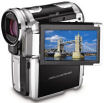
 And now for something different in earphones -- the
And now for something different in earphones -- the  The MX Air Mouse is a single device that fits both usage models: desktop and remote control.
The MX Air Mouse is a single device that fits both usage models: desktop and remote control. Perhaps the most amazing is the
Perhaps the most amazing is the  But for more constrained indoor flying, the
But for more constrained indoor flying, the  Everything is included: they run on two ordinary AA batteries; operate with simple controls to record, review, and delete clips; connect to a PC with a built-in pop-out USB connector; and even include onboard software (for Windows and Mac) to edit and share your clips.
Everything is included: they run on two ordinary AA batteries; operate with simple controls to record, review, and delete clips; connect to a PC with a built-in pop-out USB connector; and even include onboard software (for Windows and Mac) to edit and share your clips.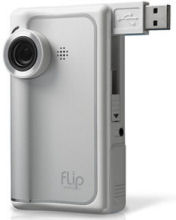 The Flip Video, released in May 2007, goes even simpler and smaller than the latest RCA Small Wonder design, by eliminating the flip-out viewfinder and memory card expansion slot.
The Flip Video, released in May 2007, goes even simpler and smaller than the latest RCA Small Wonder design, by eliminating the flip-out viewfinder and memory card expansion slot.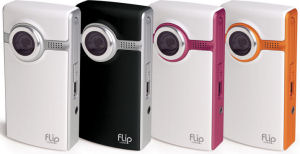 And the newer Flip Video Ultra from September 2007 adds a no-glare viewfinder and beefs up the video quality (from 2.8 to 4.5 Mbps).
And the newer Flip Video Ultra from September 2007 adds a no-glare viewfinder and beefs up the video quality (from 2.8 to 4.5 Mbps).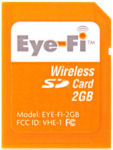 The
The  The
The 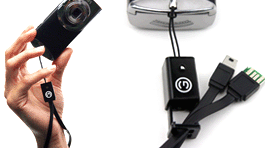 Another fun photo accessory is the
Another fun photo accessory is the 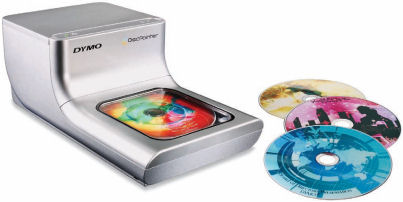
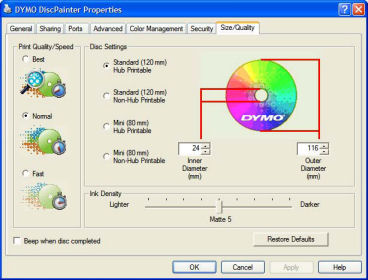 Use the printer properties dialog to set the print quality, print area on the disc, and the ink density (matte to glossy to colored discs).
Use the printer properties dialog to set the print quality, print area on the disc, and the ink density (matte to glossy to colored discs). The
The